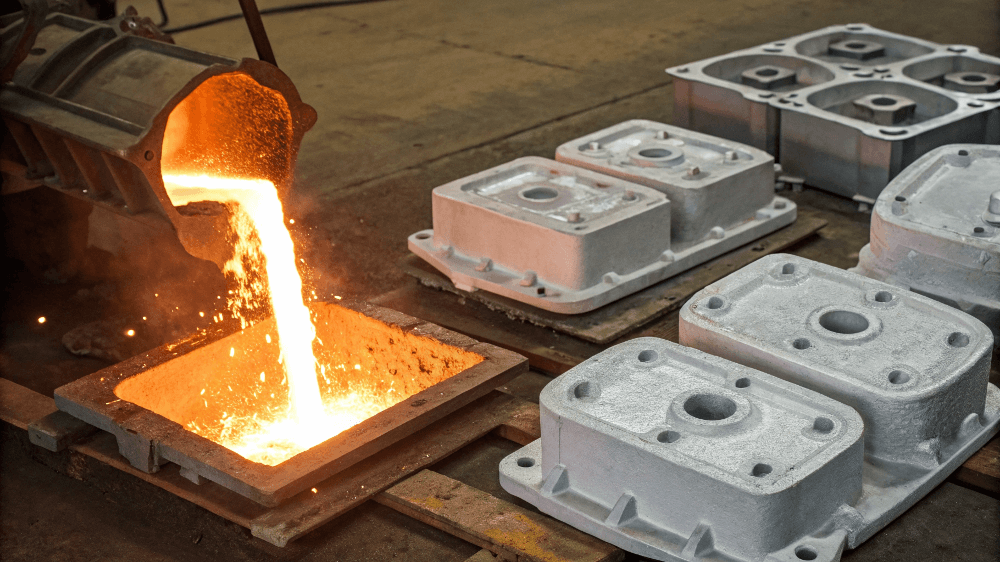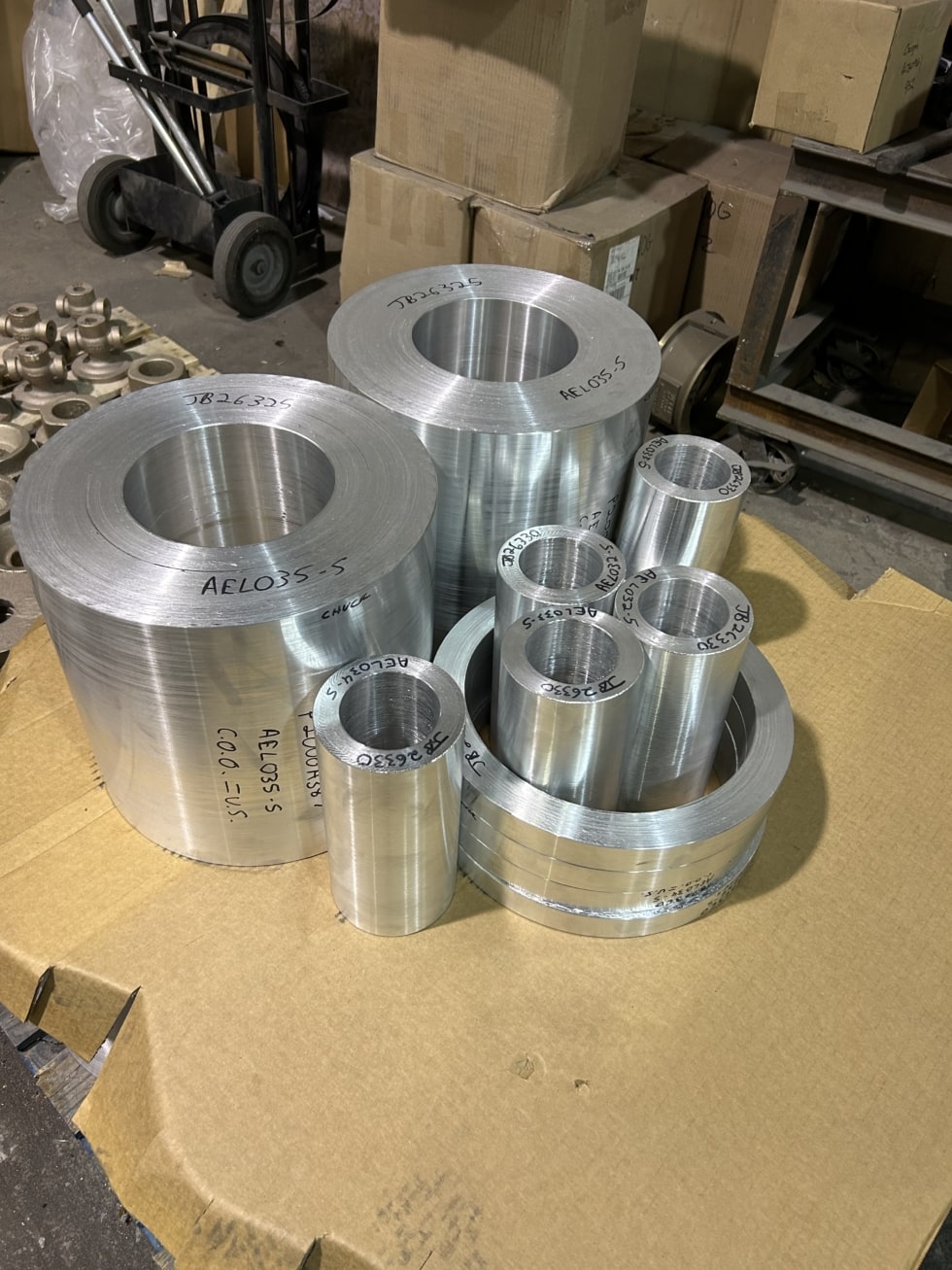Reasons why Aluminum Foundry Wisconsin is key for casting growth
Wiki Article
Just How Aluminum Foundry Adds to Improvements in Aerospace Design
Aluminum foundries are essential to improvements in aerospace design. They produce lightweight, high-strength parts that are essential for modern airplane. Through advanced casting methods, these factories develop intricate geometries that boost structural integrity. In addition, the development of superior Aluminum alloys sustains the market's concentrate on gas effectiveness and sustainability. However, obstacles stay in the production procedure. Recognizing these elements discloses the extensive impact of Aluminum on aeronautics's future.The Importance of Lightweight Products in Aerospace Layout
As the aerospace industry proceeds to evolve, the significance of lightweight products ends up being significantly obvious. The demand for effectiveness and sustainability drives engineers to focus on the use of materials that lower overall weight without endangering architectural integrity. Lightweight materials, specifically Aluminum, play an important function in enhancing gas efficiency, enhancing haul ability, and raising the general performance of airplane.Moreover, the combination of these materials enables ingenious designs, enabling makers to produce more wind resistant forms that can stand up to severe conditions. The decrease in weight not only lowers operational costs yet additionally adds to a reduced ecological impact, aligning with worldwide efforts toward sustainability in aeronautics.
Advanced Spreading Techniques in Aluminum Foundries
Advanced spreading techniques in Aluminum foundries play a vital function in aerospace design by allowing the production of specific and light-weight elements. Innovations in mold and mildew layout and accuracy casting processes are important in accomplishing optimal efficiency and structural stability. In addition, the growth of light-weight alloys improves the total effectiveness and efficiency of aerospace applications.Innovative Mold Design
Innovative mold design plays a necessary function in the effectiveness and performance of Aluminum shops, specifically within the aerospace sector. By leveraging advanced materials and techniques, contemporary mold and mildews can be engineered to withstand heats and pressures, making certain peak efficiency during the casting process. These designs often integrate complicated geometries that enable the manufacturing of light-weight yet structurally audio parts, essential for aerospace applications. Additionally, the usage of computer-aided style (CAD) software promotes accurate modeling, enabling foundries to improve and replicate mold and mildew designs before physical production starts. This not just improves the high quality of cast components but likewise lowers waste and lead times, resulting in substantial price savings. In general, ingenious mold layout is a cornerstone of development in Aluminum Foundry technology for aerospace design.Precision Casting Processes
The effectiveness of ingenious mold and mildew designs seamlessly incorporates with precision casting procedures, which are vital for generating top quality Aluminum parts in aerospace design. These procedures, including sand casting, pass away casting, and financial investment casting, assure the development of complicated geometries with limited tolerances. Advanced techniques like vacuum casting and stress die casting enhance the integrity and surface area coating of the end products. Precision casting decreases material waste while maximizing the mechanical homes of Aluminum, vital for aerospace applications. Additionally, utilizing real-time surveillance and advanced simulation tools during the casting procedure enables for prompt adjustments, resulting in enhanced high quality control. Collectively, these precision casting processes placement Aluminum factories at the forefront of aerospace advancement, sustaining the industry's need for reliability and performance.Light-weight Alloy Development
As aerospace designers look for to boost fuel effectiveness and performance, lightweight alloy growth comes to be an essential focus in Aluminum shops. These shops employ advanced casting techniques to create alloys that provide premium strength-to-weight proportions. Developments in alloy make-up, consisting of the incorporation of elements like lithium and magnesium, enable the production of materials that withstand extreme problems while reducing overall aircraft weight. Techniques such as die spreading and financial investment casting promote the precision manufacturing of complicated shapes, which are critical for aerospace applications. Additionally, recurring research aims to maximize these alloys for enhanced mechanical homes and increased resilience. By focusing on light-weight alloy growth, Aluminum foundries substantially add to the development of aerospace design, leading the way for more reliable and sustainable aircraft styles.
Enhancing Structural Stability With Aluminum Parts
Aluminum parts use considerable benefits in boosting architectural stability within aerospace design. Their lightweight nature adds to general performance while maintaining toughness, which is vital for airplane performance. Furthermore, the anxiety resistance residential properties of Aluminum help assure the durability and dependability of aerospace structures under various operational problems.
Light-weight Material Perks
While traditional products frequently jeopardize weight for strength, using Aluminum components in aerospace engineering offers significant advantages in architectural integrity. Aluminum's lightweight nature adds to general style efficiency, enabling for even more structured aircraft that take in much less fuel, thus improving sustainability. The product's exceptional strength-to-weight ratio warranties that elements maintain toughness without including unneeded mass. This quality cultivates boosted efficiency and dexterity in flight, in addition to enhanced haul capacities. Additionally, Aluminum's resistance to corrosion prolongs the lifespan of aerospace frameworks, minimizing maintenance expenses and boosting security. As suppliers significantly adopt Aluminum alloys, the aerospace market experiences a transformative shift in the direction of extra effective and reliable engineering options that prioritize both performance and ecological responsibility.Anxiety Resistance Qualities
Although different materials possess special residential or commercial properties, Aluminum's outstanding stress resistance attracts attention as a crucial consider improving the structural honesty of aerospace parts. This resistance plays an essential function in making sure that airplane can stand up to numerous operational stress and anxieties, consisting of exhaustion, effect, and ecological conditions. Aluminum alloys, especially crafted for aerospace applications, display high tensile stamina while keeping light-weight attributes, enabling designers to design much more efficient frameworks - Aluminum Foundry. Furthermore, the capacity of Aluminum to sustain cyclic loading without substantial deformation contributes to the longevity and integrity of aerospace components. As innovations continue in Aluminum Foundry methods, the development of stress-resistant Aluminum components promises further improvements in efficiency, security, and efficiency across the aerospace sector, strengthening Aluminum's duty as a favored material in modern designGas Efficiency Improvements Driven by Aluminum Innovations
As the aerospace industry looks for to improve fuel efficiency, cutting-edge usages of Aluminum have become an essential service. Aluminum's light-weight nature significantly reduces airplane weight, enabling reduced gas consumption throughout trip. This reduction in weight is vital, as even small declines can lead to considerable improvements in general fuel economic situation.Advanced Aluminum alloys, made for improved stamina and longevity, enable makers to produce components that preserve architectural stability while reducing mass - Aluminum Foundry. Additionally, the combination of Aluminum in airframes and engine parts facilitates boosted the rules of aerodynamics, adding to decreased drag and increased efficiency
The adoption of Aluminum in aerospace not only fulfills the need for fuel-efficient layout but also straightens with regulative stress for reduced exhausts. As these advancements continue to progress, they play a substantial function in establishing new standards for fuel performance, ensuring that the aerospace sector can meet expanding ecological and financial obstacles.

The Role of Aluminum in Sustainable Aeronautics Practices
The enhancing focus on sustainable air travel methods has positioned Aluminum as a necessary material in the mission for greener airplane layout. Known for its lightweight residential or commercial properties, Aluminum considerably decreases airplane weight, causing reduced gas usage and emissions. Its recyclability further improves its sustainability account, as Aluminum can be reused indefinitely without loss of top quality. This particular sustains a circular economy within the aeronautics industry, decreasing waste and source exhaustion.Moreover, developments in Aluminum alloys have actually improved their strength and deterioration resistance, enabling longer service life and lowered upkeep needs. These technologies help with the development of much more reliable airplane structures, adding to overall sustainability initiatives. Furthermore, Aluminum's thermal conductivity plays a critical function in energy-efficient layouts, enhancing systems such as warmth exchangers. Collectively, these attributes emphasize Aluminum's critical role beforehand sustainable air travel, aligning with worldwide initiatives targeted at lowering the environmental effect of air traveling.
Obstacles Dealt With by Aluminum Foundries in Aerospace Production
While Aluminum factories play a vital duty in aerospace manufacturing, they encounter considerable challenges that can impact manufacturing efficiency and top quality. One major obstacle is the strict top quality control standards required in the aerospace sector. Any kind of flaw can endanger security and efficiency, necessitating extensive assessment procedures that extend manufacturing timelines. Furthermore, factories commonly compete with varying resources prices, which can influence pricing and profitability. The complexity of Aluminum alloys utilized in aerospace applications further complicates the manufacturing procedure, as specific formulas are crucial for achieving wanted mechanical homes. Competent labor lacks prevent the capacity to preserve high-quality manufacturing degrees. Ultimately, environmental guidelines impose restrictions on exhausts and waste monitoring, needing foundries to purchase lasting techniques, which can be cost-prohibitive. These variables collectively produce a landscape where Aluminum foundries have to constantly adapt to satisfy the progressing needs of aerospace manufacturing while making certain security and compliance.Future Fads in Aluminum Applications for Aerospace Design
With developments in modern technology and enhancing needs for efficiency, the future of Aluminum applications in aerospace design is positioned for substantial change. The integration of ingenious Aluminum alloys and compounds is anticipated to enhance strength-to-weight ratios, resulting in more fuel-efficient airplane layouts. Furthermore, improvements in additive manufacturing techniques will certainly permit the production of complicated Aluminum structures that were previously impossible, optimizing performance and decreasing waste.
Sustainable methods will certainly play a crucial function, with a growing focus on recycling Aluminum to reduce environmental impact. The aerospace industry is most likely to welcome smarter producing procedures, such as automation and fabricated intelligence, guaranteeing better and precision in Aluminum parts. Collaborations between Aluminum shops and aerospace companies will promote research and development, paving the way for brand-new applications that satisfy the stringent requirements of modern-day aerospace design. In general, the future looks promising for Aluminum's duty in shaping the skies
Often Asked Questions
What Are the Environmental Influences of Aluminum Production in Aerospace?
The environmental impacts of Aluminum manufacturing in aerospace consist of considerable energy intake, greenhouse gas emissions, and habitat disruption. In addition, mining processes can lead to soil deterioration and water contamination, elevating issues about sustainability and environmental equilibrium.Exactly How Does Aluminum Compare to Other Materials in Aerospace Applications?
Aluminum provides a distinct mix of lightweight residential properties, deterioration resistance, and cost-effectiveness compared to various other materials. Its high strength-to-weight proportion makes it particularly helpful for aerospace applications, enhancing fuel performance and general performance in aircraft style.What Credentials Do Aluminum Foundry Employees Demand for Aerospace Projects?
Aluminum Foundry employees require specific training in metallurgy and casting methods, together with understanding of aerospace market criteria. Qualifications in top quality control and safety and security procedures are likewise vital to ensure conformity with rigid aerospace job needs.Exist Any Type Of Safety Worry About Utilizing Aluminum in Aerospace Engineering?
Safety and security concerns concerning Aluminum in aerospace engineering include vulnerability to exhaustion, stress, and corrosion cracks. Appropriate therapy and alloy choice are necessary to mitigate these threats, making sure structural integrity and overall security in aerospace applications.How Does Aluminum Recycling Benefit the Aerospace Industry?
Aluminum recycling greatly benefits the aerospace industry by reducing product expenses, minimizing ecological impact, and conserving power. This lasting technique enhances the industry's effectiveness while advertising using light-weight, high-performance parts in aircraft production.Advanced casting techniques in Aluminum shops play an essential function in aerospace engineering by making it possible for the manufacturing of accurate and light-weight parts. Innovative mold layout plays a necessary role in the performance and performance of Aluminum foundries, particularly within the aerospace market. As aerospace designers seek to improve gas performance and efficiency, light-weight alloy growth ends up being an important emphasis in Aluminum foundries. Aluminum alloys, specifically engineered for aerospace applications, display high tensile toughness while maintaining light-weight attributes, enabling designers to design extra effective frameworks. Collaborations between Aluminum shops and aerospace business will certainly promote research study and growth, paving the means for new applications Aluminum Foundry Wisconsin that fulfill the rigid requirements of contemporary aerospace design.
Report this wiki page